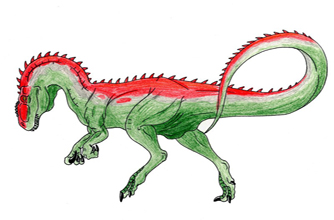
Megaraptor Dinosaur meaning "giant thief," is an intriguing dinosaur that lived during the Late Cretaceous period, approximately 95-70 million years ago. Despite its name, Megaraptor is not actually a member of the raptor family (dromaeosaurids), but rather belongs to a group of theropod dinosaurs known as the Megaraptorans. With its unique characteristics and debated classification, Megaraptor continues to fascinate paleontologists.
Megaraptor was a large dinosaur, estimated to have reached lengths of up to 26 feet (8 meters). Its most distinguishing feature was its large, curved, and serrated claws on the second toe of its feet, similar to those found in some dromaeosaurids. These sharp claws, measuring around 13 inches (33 centimeters) in length, were likely used for grasping and slashing prey. The anatomy of Megaraptor is still a subject of scientific debate due to incomplete fossil remains. However, based on the discovered fossils, it is believed to have had a slender body with a long neck and tail. Its skull was relatively small and equipped with sharp teeth, indicating a carnivorous diet.
Megaraptor Facts :
| Name: | Megaraptor Dinosaurs |
| Size: | 8 meters |
| Main Facts: | Megaraptor, meaning "giant thief," is an intriguing dinosaur that lived during the Late Cretaceous period, approximately 95-70 million years ago. |
One of the key features that differentiate Megaraptor from other theropods is its forelimbs. Fossil evidence suggests that Megaraptor had exceptionally long arms, much longer than those of most theropods. The arms were slender and ended in three-fingered hands, which may have been used for grasping and manipulating prey. This unique adaptation sets Megaraptor apart and gives it a distinct appearance among theropod dinosaurs.
Megaraptor fossils have been found in South America, specifically in Argentina. It inhabited diverse environments such as forests, grasslands, and river systems. Its diet likely consisted of small to medium-sized animals, including other dinosaurs, small mammals, and possibly even fish.